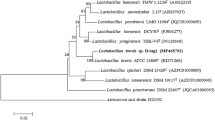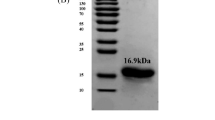Abstract
The double-site variant (C450S-N475K) l-arabinose isomerase (l-AI) from Geobacillus thermodenitrificans catalyzes the isomerization of d-galactose to d-tagatose, a functional sweetener. Using a substrate-docking homology model, the residues near to d-galactose O6 were identified as Met186, Phe280, and Ile371. Several variants obtained by site-directed mutagenesis of these three residues were analyzed, and a triple-site (F280N) variant enzyme exhibited the highest activity for d-galactose isomerization. The k cat/K m of the triple-site variant enzyme for d-galactose was 2.1-fold higher than for l-arabinose, whereas the k cat/K m of the double-site variant enzyme for l-arabinose was 43.9-fold higher than for d-galactose. These results suggest that the triple-site variant enzyme is a d-galactose isomerase. The conversion rate of d-galactose to d-tagatose by the triple-site variant enzyme was approximately 3-fold higher than that of the double-site variant enzyme for 30 min. However, the conversion yields of l-arabinose to l-ribulose by the triple-site and double-site variant enzymes were 10.6 and 16.0 % after 20 min, respectively. The triple-site variant enzyme exhibited increased specific activity, turnover number, catalytic efficiency, and conversion rate for d-galactose isomerization compared to the double-site variant enzyme. Therefore, the amino acid at position 280 determines the substrate specificity for d-galactose and l-arabinose, and the triple-site variant enzyme has the potential to produce d-tagatose on an industrial scale.





Similar content being viewed by others
References
Al-Balas Q, Hassan M, Al-Oudat B, Alzoubi H, Mhaidat N, Almaaytah A (2012) Generation of the first structure-based pharmacophore model containing a selective “zinc binding group” feature to identify potential glyoxalase-1 inhibitors. Molecules 17:13740–13758
Ansari MY, Dikhit MR, Sahoo GC, Das P (2012) Comparative modeling of HGPRT enzyme of L. donovani and binding affinities of different analogs of GMP. Int J Biol Macromol 50:637–649
Baek DH, Lee Y, Sin HS, Oh DK (2004) A new thermophile strain of Geobacillus thermodenitrificans having L-arabinose isomerase activity for tagatose production. J Microbiol Biotechnol 14:312–316
Cheetham P, Wootton A (1993) Bioconversion of D-galactose into D-tagatose. Enzym Microbiol Technol 15:105–108
Cheng L, Mu W, Zhang T, Jiang B (2013) An L-arabinose isomerase from Acidothermus cellulolytics ATCC 43068: cloning, expression, purification, and characterization. Appl Microbiol Biotechnol 86:1089–1097
Chouayekh H, Bejar W, Rhimi M, Jelleli K, Mseddi M, Bejar S (2007) Characterization of an L-arabinose isomerase from the Lactobacillus plantarum NC8 strain showing pronounced stability at acidic pH. FEMS Microbiol Lett 277:260–267
Espinosa I, Fogelfeld L (2010) Tagatose: from a sweetener to a new diabetic medication? Expert Opin Investig Drugs 19:285–294
Hung XG, Tseng WC, Tzou WS, Fang TY (2014) Characterization of a thermophilic L-arabinose isomerase from Thermoanaerobacterium saccharolyticum NTOU1. Biochem Eng J 83:121–128
Jorgensen F, Hansen OC, Stougaard P (2004) Enzymatic conversion of D-galactose to D-tagatose: heterologous expression and characterisation of a thermostable L-arabinose isomerase from Thermoanaerobacter mathranii. Appl Microbiol Biotechnol 64:816–822
Kim HJ, Oh DK (2005) Purification and characterization of an L-arabinose isomerase from an isolated strain of Geobacillus thermodenitrificans producing D-tagatose. J Biotechnol 120:162–173
Kim BC, Lee YH, Lee HS, Lee DW, Choe EA, Pyun YR (2002) Cloning, expression and characterization of L-arabinose isomerase from Thermotoga neapolitana: bioconversion of D-galactose to D-tagatose using the enzyme. FEMS Microbiol Lett 212:121–126
Kim JW, Kim YW, Roh HJ, Kim HY, Cha JH, Park KH, Park CS (2003) Production of tagatose by a recombinant thermostable L-arabinose isomerase from Thermus sp. IM6501. Biotechnol Lett 25:963–967
Kim HJ, Kim JH, Oh HJ, Oh DK (2006) Characterization of a mutated Geobacillus stearothermophilus L-arabinose isomerase that increases the production rate of D-tagatose. J Appl Microbiol 101:213–221
Kim JH, Prabhu P, Jeya M, Tiwari MK, Moon HJ, Singh RK, Lee JK (2010) Characterization of an L-arabinose isomerase from Bacillus subtilis. Appl Microbiol Biotechnol 85:1839–1847
Kräutler V, van Gunsteen WF, Hünenberger PH (2001) A fast SHAKE algorithm to solve distance constraint equations for small molecules in molecular dynamics simulations. J Comput Chem 22
Laskowski RA, Moss DS, Thornton JM (1993) Main-chain bond lengths and bond angles in protein structures. J Mol Biol 231:1049–1067
Lee DW, Jang HJ, Choe EA, Kim BC, Lee SJ, Kim SB, Hong YH, Pyun YR (2004) Characterization of a thermostable L-arabinose (D-galactose) isomerase from the hyperthermophilic eubacterium Thermotoga maritima. Appl Environ Microbiol 70:1397–1404
Lee DW, Choe EA, Kim SB, Eom SH, Hong YH, Lee SJ, Lee HS, Lee DY, Pyun YR (2005a) Distinct metal dependence for catalytic and structural functions in the L-arabinose isomerases from the mesophilic Bacillus halodurans and the thermophilic Geobacillus stearothermophilus. Arch Biochem Biophys 434:333–343
Lee SJ, Lee DW, Choe EA, Hong YH, Kim SB, Kim BC, Pyun YR (2005b) Characterization of a thermoacidophilic L-arabinose isomerase from Alicyclobacillus acidocaldarius: role of Lys-269 in pH optimum. Appl Environ Microbiol 71:7888–7896
Levin GV (2002) Tagatose, the new GRAS sweetener and health product. J Med Food 5:23–36
Li Y, Zhu Y, Liu A, Sun Y (2011) Identification and characterization of a novel L-arabinose isomerase from Anoxybacillus flavithermus useful in D-tagatose production. Extremophiles 15:441–450
Liu SY, Wiegel J, Gherardini FC (1996) Purification and cloning of a thermostable xylose (glucose) isomerase with an acidic pH optimum from Thermoanaerobacterium strain JW/SL-YS 489. J Bacteriol 178:5938–5945
Lu Y, Levin GV, Donner TW (2008) Tagatose, a new antidiabetic and obesity control drug. Diabetes Obes Metab 10:109–134
Manjasetty BA, Chance MR (2006) Crystal structure of Escherichia coli L-arabinose isomerase (ECAI), the putative target of biological tagatose production. J Mol Biol 360:297–309
Marti-Renom MA, Stuart AC, Fiser A, Sanchez R, Melo F, Sali A (2000) Comparative protein structure modeling of genes and genomes. Annu Rev Biophys Biomol Struct 29:291–325
Men Y, Zhu Y, Zhang L, Kang Z, Izumori K, Sun Y, Ma Y (2014) Enzymatic conversion of D-galactose to D-tagatose: cloning, overexpression and characterization of L-arabinose isomerase from Pediococcus pentosaceus PC-5. Microbiol Res 169:171–178
Mendoza MR, Olano A, Villamiel M (2005) Chemical indicators of heat treatment in fortified and special milks. J Agric Food Chem 53:2995–2999
Oh DK (2007) Tagatose: properties, applications, and biotechnological processes. Appl Microbiol Biotechnol 76:1–8
Oh HJ, Kim HJ, Oh DK (2006) Increase in D-tagatose production rate by site-directed mutagenesis of L-arabinose isomerase from Geobacillus thermodenitrificans. Biotechnol Lett 28:145–149
Prabhu P, Tiwari MK, Jeya M, Gunasekaran P, Kim IW, Lee JK (2008) Cloning and characterization of a novel L-arabinose isomerase from Bacillus licheniformis. Appl Microbiol Biotechnol 81:283–290
Radestock S, Gohlke H (2011) Protein rigidity and thermophilic adaptation. Proteins 79:1089–1108
Rhimi M, Bejar S (2006) Cloning, purification and biochemical characterization of metallic-ions independent and thermoactive L-arabinose isomerase from the Bacillus stearothermophilus US100 strain. Biochim Biophys Acta 1760:191–199
Rhimi M, Juy M, Aghajari N, Haser R, Bejar S (2007) Probing the essential catalytic residues and substrate affinity in the thermoactive Bacillus stearothermophilus US100 L-arabinose isomerase by site-directed mutagenesis. J Bacteriol 189:3556–3563
Rhimi M, Ilhammami R, Bajic G, Boudebbouze S, Maguin E, Haser R, Aghajari N (2010) The acid tolerant L-arabinose isomerase from the food grade Lactobacillus sakei 23 K is an attractive D-tagatose producer. Bioresour Technol 101:9171–9177
Rhimi M, Bajic G, Ilhammami R, Boudebbouze S, Maguin E, Haser R, Aghajari N (2011) The acid-tolerant L-arabinose isomerase from the mesophilic Shewanella sp. ANA-3 is highly active at low temperatures. Microbiol Cell Fact 10:96
Salonen N, Nyyssola A, Salonen K, Turunen O (2012) Bifidobacterium longum L-arabinose isomerase-overexpression in Lactococcus lactis, purification, and characterization. Appl Biochem Biotechnol 168:392–405
Seo MJ (2013) Characterization of an L-arabinose isomerase from Bacillus thermoglucosidasius for D-tagatose production. Biosci Biotechnol Biochem 77:385–388
Spassov VZ, Yan L (2013) pH-selective mutagenesis of protein–protein interfaces: in silico design of therapeutic antibodies with prolonged half-life. Proteins Struct Funct Bioinforma 81:701–714
Wu G, Robertson DH, Brooks CL 3rd, Vieth M (2003) Detailed analysis of grid-based molecular docking: a case study of CDOCKER-A CHARMm-based MD docking algorithm. J Comput Chem 24:1549–1562
Xu Z, Qing YJ, Li S, Feng XH, Xu H, Ouyang PK (2011) A novel L-arabinose isomerase from Lactobacillus fermentum CGMCC2921 for D-tagatose production: gene cloning, purification and characterization. J Mol Catal B Enzym 70:1–7
Yamanaka K, Wood WA (1966) L-Arabinose isomerase. Methods Enzymol 9:596–602
Yoon SH, Kim P, Oh DK (2003) Properties of L-arabinose isomerase from Escherichia coli as biocatalyst for tagatose production. World J Microbiol Biotechnol 19:47–51
Zhou X, Wu JC (2012) Heterologous expression and characterization of Bacillus coagulans L-arabinose isomerase. World J Microbiol Biotechnol 28:2205–2212
Acknowledgments
This work was supported by the Basic Research Lab program (No. 2013-A423-0061) of the National Research Foundation, the Ministry of Education, Science and Technology, and by a grant (No. 311042-5) from the Korea Institute of Planning and Evaluation for Technology, the Ministry of Food, Agriculture, Forestry and Fisheries, South Korea.
Author information
Authors and Affiliations
Corresponding author
Electronic supplementary material
Below is the link to the electronic supplementary material.
Fig. S1
(PDF 142 kb)
Rights and permissions
About this article
Cite this article
Kim, BJ., Hong, SH., Shin, KC. et al. Characterization of a F280N variant of l-arabinose isomerase from Geobacillus thermodenitrificans identified as a d-galactose isomerase. Appl Microbiol Biotechnol 98, 9271–9281 (2014). https://doi.org/10.1007/s00253-014-5827-z
Received:
Revised:
Accepted:
Published:
Issue Date:
DOI: https://doi.org/10.1007/s00253-014-5827-z




